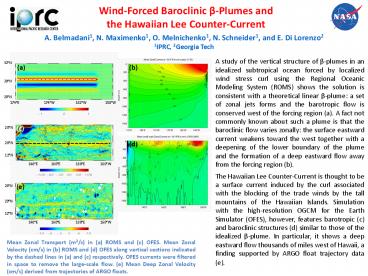A study of the vertical structure of PowerPoint PPT Presentation
Title: A study of the vertical structure of
1
Wind-Forced Baroclinic ß-Plumes and the Hawaiian
Lee Counter-Current
A. Belmadani1, N. Maximenko1, O. Melnichenko1, N.
Schneider1, and E. Di Lorenzo2 1IPRC, 2Georgia
Tech
A study of the vertical structure of ß-plumes in
an idealized subtropical ocean forced by
localized wind stress curl using the Regional
Oceanic Modeling System (ROMS) shows the solution
is consistent with a theoretical linear ß-plume
a set of zonal jets forms and the barotropic flow
is conserved west of the forcing region (a). A
fact not commonly known about such a plume is
that the baroclinic flow varies zonally the
surface eastward current weakens toward the west
together with a deepening of the lower boundary
of the plume and the formation of a deep eastward
flow away from the forcing region (b). The
Hawaiian Lee Counter-Current is thought to be a
surface current induced by the curl associated
with the blocking of the trade winds by the tall
mountains of the Hawaiian Islands. Simulation
with the high-resolution OGCM for the Earth
Simulator (OFES), however, features barotropic
(c) and baroclinic structures (d) similar to
those of the idealized ß-plume. In particular, it
shows a deep eastward flow thousands of miles
west of Hawaii, a finding supported by ARGO float
trajectory data (e).
32N
(b)
(a)
30N
28N
174E
174W
162W
150W
28N
(c)
20N
12N
160W
180E
160E
140E
28N
(e)
20N
12N
160W
180E
160E
140E
Mean Zonal Transport (m2/s) in (a) ROMS and (c)
OFES. Mean Zonal Velocity (cm/s) in (b) ROMS and
(d) OFES along vertical sections indicated by the
dashed lines in (a) and (c) respectively. OFES
currents were filtered in space to remove the
large-scale flow. (e) Mean Deep Zonal Velocity
(cm/s) derived from trajectories of ARGO floats.
PowerShow.com is a leading presentation sharing website. It has millions of presentations already uploaded and available with 1,000s more being uploaded by its users every day. Whatever your area of interest, here you’ll be able to find and view presentations you’ll love and possibly download. And, best of all, it is completely free and easy to use.
You might even have a presentation you’d like to share with others. If so, just upload it to PowerShow.com. We’ll convert it to an HTML5 slideshow that includes all the media types you’ve already added: audio, video, music, pictures, animations and transition effects. Then you can share it with your target audience as well as PowerShow.com’s millions of monthly visitors. And, again, it’s all free.
About the Developers
PowerShow.com is brought to you by CrystalGraphics, the award-winning developer and market-leading publisher of rich-media enhancement products for presentations. Our product offerings include millions of PowerPoint templates, diagrams, animated 3D characters and more.

